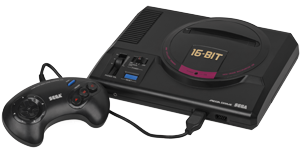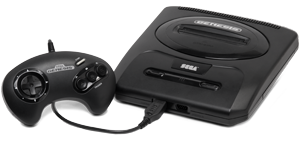Sega Genesis: Difference between revisions
No edit summary |
|||
| Line 1: | Line 1: | ||
The '''Mega Drive''' | {{Infobox Platform | ||
| name = Sega Genesis / Mega Drive | |||
| logo = [[File:Genesis Logo.png|250px|North American logo]]<br/>[[File:Megadrive Logo.png|250px|European/Australasian logo]] | |||
| image = {{nowrap|[[File:Sega Mega Drive JP Mod1 Console.png|300px|The original Japanese Mega Drive]]<br>[[File:Sega Genesis Console Mod2.png|300px|Model 2 Sega Genesis w/ controller]]}} | |||
| caption = '''Top:''' Original Japanese Mega Drive <br/> '''Bottom:''' Sega Genesis model 2 | |||
| manufacturer = Sega | |||
| type = Video game console | |||
| generation = Fourth generation | |||
| release date = {{vgrelease|JP=October 29, 1988|NA=August 14, 1989|PAL=November 30, 1990|}} | |||
| discontinued = {{vgrelease|JP=1995|NA=1997}} | |||
| media = ROM cartridge | |||
| CPU = Motorola 68000 and Zilog Z80 | |||
| onlineservice = Sega Meganet, Sega Channel, XBAND | |||
| unitssold = Estimated from 37.3 to over 40.9 million | |||
| topgame = ''[[Sonic the Hedgehog]]'' (pack-in), 15 million<br />''Disney's Aladdin'', 4 million | |||
| predecessor = [[Sega Master System]] | |||
| successor = [[wikipedia:Sega Saturn|Sega Saturn]] | |||
}} | |||
The '''Sega Genesis''' is a [[wikipedia:History of video game consoles (fourth generation)|fourth-generation]] [[wikipedia:video game console|video game console]] developed and produced by [[wikipedia:Sega|Sega]]. It was originally released in Japan in 1988 as '''Mega Drive''' (メガドライブ Mega Doraibu?), then in North America in 1989 as '''Sega Genesis''', and in Europe, Australia and other PAL regions in 1990 as '''Mega Drive'''. The reason for the two names is that Sega was unable to secure legal rights to the Mega Drive name in North America. The Sega Genesis is Sega's third console and the successor to the [[Sega Master System]] with which it has [[wikipedia:Backward compatibility|backwards compatibility]] (with the [[wikipedia:Sega Genesis#Master System compatibility|Sega Power Base Converter]]). | |||
The Sega Genesis was the first of its generation to achieve notable market share in Europe and North America. The Sega Genesis was launched to compete with the [[Nintendo Entertainment System]] and NEC's [[TurboGrafx-16|PC-Engine/TurboGrafx-16]]. Two years later, Nintendo released the [[Super Nintendo Entertainment System]], and the competition between the two would dominate the 16-bit era of video gaming. While technically inferior to the newer SNES, the Sega Genesis enjoyed significant 3rd party support, in large part because it did not censor games as severely as the SNES, using a rating system instead. The rating system allowed for accurate arcade ports and controversial games to thrive on the console, and proved so successful that Nintendo adopted the rating system, leading to the [[wikipedia:ESRB|ESRB]]. | |||
The Sega Genesis is well known for its wide variety of [[wikipedia:Variations of the Sega Mega Drive|variations]] and [[wikipedia:Sega Genesis#Add-ons|addons]]. Two add-ons, the [[wikipedia:Sega CD|Sega CD]] and [[wikipedia:Sega 32X|Sega 32X]], were even designed to extend the capabilities of the console to compete with 32bit consoles. These briefly supported add-ons and variations made developers weary of the Sega brand, which lead many of them to embrace competitor consoles in the [[wikipedia:History of video game consoles (fifth generation)|fifth-generation]]. This legacy would continue to plague Sega even into the [[wikipedia:History of video game consoles (sixth generation)|sixth-generation]], and was partially responsible for the fall of Sega as a hardware developer. | |||
The console and its games continue to be popular among fans, collectors, retro gamers, emulation enthusiasts and the [[wikipedia:fan translation|fan translation]] scene. Licensed 3rd party variations of the console are still being produced to this day, and there are also several indie game developers continuing to produce games for the console. Many games have been re-released in compilations for newer consoles or offered for download on various online services. | |||
The Sega Genesis began production in Japan in 1988 and ended with the last new licensed game being released in 2002 in Brazil, outlasting both of its successors. The Sega Genesis was Sega's most successful console; though Sega has never released a total sales figure quote, sales estimates in the past have ranged from as low as 29 million to over 40.8 million. It was succeeded in 1994 with the release of the [[wikipedia:Sega Saturn|Sega Saturn]]. | |||
== Virtual Console Compatibility List (Sega Genesis/Megadrive) == | |||
'''Help to complete the list!''' | '''Help to complete the list!''' | ||
*If a game is missing or information is incomplete, | *If a game is missing or information is incomplete, go to the [[Template:Virtual Console/Sega Genesis|Sega Genesis VC Ratings Template]], then press edit at the top of that page. '''Please put in alphabetical order!''' | ||
*If there are problems with a game | *If you want to update a game's rating, click the icon [[file:Note.svg.png]] to the right of the rating stars, and put just a number of 1 through 5 into the page. Use the compatibility guide below as a reference for what rating to use. | ||
*If there are problems with a game, go to the page for that game and write down the problem! | |||
{{Compatibility}} | |||
{{Region}} | |||
{{compactTOC8|top=no|num=yes|side=yes}} | <!-- To edit the N64 VC Compatibility list, navigate to "Template:Virtual Console/Sega Genesis" (copy to the search box)-->{{compactTOC8|top=no|num=yes|side=yes}} | ||
{|class="wikitable sortable width=100%" | {|class="wikitable sortable width=100%" | ||
! Title !! Year !! Genre !! Region !! Compatibility | ! Title !! Year !! Genre !! Region !! Compatibility | ||
Revision as of 06:44, 25 March 2012
 | |
|---|---|
  Top: Original Japanese Mega Drive Bottom: Sega Genesis model 2 | |
| Manufacturer | Sega |
| Type | Video game console |
| Generation | Fourth generation |
| Release date(s) | JP October 29, 1988 NA August 14, 1989 |
| Discontinued | JP 1995 NA 1997 |
| Units sold | Estimated from 37.3 to over 40.9 million |
| Media | ROM cartridge |
| CPU | Motorola 68000 and Zilog Z80 |
| Online services | Sega Meganet, Sega Channel, XBAND |
| Best-selling game | Sonic the Hedgehog (pack-in), 15 million Disney's Aladdin, 4 million |
| Predecessor | Sega Master System |
| Successor | Sega Saturn |
The Sega Genesis is a fourth-generation video game console developed and produced by Sega. It was originally released in Japan in 1988 as Mega Drive (メガドライブ Mega Doraibu?), then in North America in 1989 as Sega Genesis, and in Europe, Australia and other PAL regions in 1990 as Mega Drive. The reason for the two names is that Sega was unable to secure legal rights to the Mega Drive name in North America. The Sega Genesis is Sega's third console and the successor to the Sega Master System with which it has backwards compatibility (with the Sega Power Base Converter).
The Sega Genesis was the first of its generation to achieve notable market share in Europe and North America. The Sega Genesis was launched to compete with the Nintendo Entertainment System and NEC's PC-Engine/TurboGrafx-16. Two years later, Nintendo released the Super Nintendo Entertainment System, and the competition between the two would dominate the 16-bit era of video gaming. While technically inferior to the newer SNES, the Sega Genesis enjoyed significant 3rd party support, in large part because it did not censor games as severely as the SNES, using a rating system instead. The rating system allowed for accurate arcade ports and controversial games to thrive on the console, and proved so successful that Nintendo adopted the rating system, leading to the ESRB.
The Sega Genesis is well known for its wide variety of variations and addons. Two add-ons, the Sega CD and Sega 32X, were even designed to extend the capabilities of the console to compete with 32bit consoles. These briefly supported add-ons and variations made developers weary of the Sega brand, which lead many of them to embrace competitor consoles in the fifth-generation. This legacy would continue to plague Sega even into the sixth-generation, and was partially responsible for the fall of Sega as a hardware developer.
The console and its games continue to be popular among fans, collectors, retro gamers, emulation enthusiasts and the fan translation scene. Licensed 3rd party variations of the console are still being produced to this day, and there are also several indie game developers continuing to produce games for the console. Many games have been re-released in compilations for newer consoles or offered for download on various online services.
The Sega Genesis began production in Japan in 1988 and ended with the last new licensed game being released in 2002 in Brazil, outlasting both of its successors. The Sega Genesis was Sega's most successful console; though Sega has never released a total sales figure quote, sales estimates in the past have ranged from as low as 29 million to over 40.8 million. It was succeeded in 1994 with the release of the Sega Saturn.
Virtual Console Compatibility List (Sega Genesis/Megadrive)
Help to complete the list!
- If a game is missing or information is incomplete, go to the Sega Genesis VC Ratings Template, then press edit at the top of that page. Please put in alphabetical order!
- If you want to update a game's rating, click the icon
 to the right of the rating stars, and put just a number of 1 through 5 into the page. Use the compatibility guide below as a reference for what rating to use.
to the right of the rating stars, and put just a number of 1 through 5 into the page. Use the compatibility guide below as a reference for what rating to use. - If there are problems with a game, go to the page for that game and write down the problem!
| Region indicator | Region description |
|---|---|
| AU | Australia |
| CA | Canada (NTSC /w French translation) |
| EU | Europe, PAL/SECAM territories |
| JP | Japan and Asia (NTSC-J) |
| KO | Korea |
| NA | North America and NTSC territories |
| RU | Russia |
| Title | Year | Genre | Region | Compatibility |
|---|